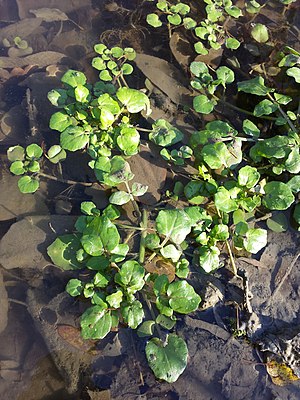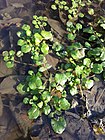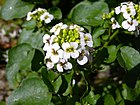Note: This is a project under development. The articles on this wiki are just being initiated and broadly incomplete. You can Help creating new pages.
Difference between revisions of "Nasturtium officinale"
| Line 1: | Line 1: | ||
| − | + | [[File:Nasturtium officinale (s. str.) sl9.jpg|thumb|right]] | |
| + | '''Nasturtium officinale''' is a very succulent, aquatic, perennial plant with stems that can be 50cm or more long. The plant is a fairly well-known salad crop, often gathered from the wild but also grown commercially and sold in markets. It is also seen as a very healthy, vitamin and mineral rich food and, as such, has gained a reputation for its medicinal uses. | ||
==Uses== | ==Uses== | ||
| − | {{Uses|}}, {{Uses|}}, {{Uses|}}, {{Uses|}}, {{Uses|}} | + | {{Uses|TB}}, {{Uses|Kidney complaints}}, {{Uses|Chronic irritations}}, {{Uses|Inflammations of the skin}}, {{Uses|Stomach upsets}}..<ref name="Uses"/> |
==Parts Used== | ==Parts Used== | ||
| Line 7: | Line 8: | ||
==Chemical Composition== | ==Chemical Composition== | ||
| − | <ref name="chemical composition"/> | + | It contains main compounds of the oil of leaves were myristicin (57.6%), α-terpinolene (8.9%) and limonene (6.7%). Caryophyllene oxide (37.2%), p-cymene-8-ol (17.6%), α-terpinolene (15.2%) and limonene (11.8%) were the main components in stems, whereas limonene (43.6%), α-terpinolene (19.7%), p-cymene-8-ol (7.6%) and caryophyllene oxide (6.7%) were the major constituents in the oil of flowers.<ref name="chemical composition"/> |
==Common names== | ==Common names== | ||
| Line 16: | Line 17: | ||
===Dravya=== | ===Dravya=== | ||
===Rasa=== | ===Rasa=== | ||
| − | |||
===Guna=== | ===Guna=== | ||
| Line 48: | Line 48: | ||
==Mode of Propagation== | ==Mode of Propagation== | ||
| − | {{Propagation|}} | + | {{Propagation|Cuttings}}, {{Propagation|Seeds}}. |
==How to plant/cultivate== | ==How to plant/cultivate== | ||
| − | <ref name="How to plant/cultivate"/> | + | Watercress is a plant of the temperate zone, but it can be cultivated in the tropics at elevations between 1,000 - 3,000 metres.<ref name="How to plant/cultivate"/> |
==Commonly seen growing in areas== | ==Commonly seen growing in areas== | ||
| − | {{Commonly seen|}}, {{Commonly seen|}}, {{Commonly seen|}}, {{Commonly seen| | + | {{Commonly seen|Stream margins}}, {{Commonly seen|Ditches}}, {{Commonly seen|Flushes}}, {{Commonly seen|Limestone areas}}. |
==Photo Gallery== | ==Photo Gallery== | ||
<gallery class="left" caption="" widths="140px" heights="140px"> | <gallery class="left" caption="" widths="140px" heights="140px"> | ||
| − | + | Nasturtium officinale (s. str.) sl9.jpg | |
| + | Nasturtium officinale - Su teresi.jpg | ||
| + | Nasturtium officinale BOGA.jpg | ||
| + | Nasturtium officinale Common Wattercress წყლის წიწმატი.JPG | ||
| + | Nasturtium officinale marais-blangy-tronville 80 25052007 1.jpg | ||
</gallery> | </gallery> | ||
| Line 64: | Line 68: | ||
<references> | <references> | ||
| − | <ref name="chemical composition">[ | + | <ref name="chemical composition">[https://pubmed.ncbi.nlm.nih.gov/21815727/ Chemical constituents]</ref> |
| − | <ref name="Leaf">[ | + | <ref name="Leaf">[Morphology]</ref> |
| − | <ref name="How to plant/cultivate">[ | + | <ref name="How to plant/cultivate">[Cultivation]</ref> |
<ref name="Uses">Indian Medicinal Plants by C.P.Khare</ref> | <ref name="Uses">Indian Medicinal Plants by C.P.Khare</ref> | ||
</references> | </references> | ||
==External Links== | ==External Links== | ||
| − | * [ ] | + | * [https://www.sciencedirect.com/topics/agricultural-and-biological-sciences/nasturtium-officinale Nasturtium officinale on www.sciencedirect.com] |
| − | * [ ] | + | * [https://pfaf.org/user/plant.aspx?latinname=Nasturtium+officinale Nasturtium officinale on pfaf.org] |
| − | + | ||
[[Category:Herbs]] | [[Category:Herbs]] | ||
[[Category:Pages without herbs images]] | [[Category:Pages without herbs images]] | ||
Latest revision as of 15:53, 25 June 2020
Nasturtium officinale is a very succulent, aquatic, perennial plant with stems that can be 50cm or more long. The plant is a fairly well-known salad crop, often gathered from the wild but also grown commercially and sold in markets. It is also seen as a very healthy, vitamin and mineral rich food and, as such, has gained a reputation for its medicinal uses.
Contents
- 1 Uses
- 2 Parts Used
- 3 Chemical Composition
- 4 Common names
- 5 Properties
- 6 Habit
- 7 Identification
- 8 List of Ayurvedic medicine in which the herb is used
- 9 Where to get the saplings
- 10 Mode of Propagation
- 11 How to plant/cultivate
- 12 Commonly seen growing in areas
- 13 Photo Gallery
- 14 References
- 15 External Links
Uses
TB, Kidney complaints, Chronic irritations, Inflammations of the skin, Stomach upsets..[1]
Parts Used
[[:Category:Herbs with used in medicine|]], stem, leaves, Root.
Chemical Composition
It contains main compounds of the oil of leaves were myristicin (57.6%), α-terpinolene (8.9%) and limonene (6.7%). Caryophyllene oxide (37.2%), p-cymene-8-ol (17.6%), α-terpinolene (15.2%) and limonene (11.8%) were the main components in stems, whereas limonene (43.6%), α-terpinolene (19.7%), p-cymene-8-ol (7.6%) and caryophyllene oxide (6.7%) were the major constituents in the oil of flowers.[2]
Common names
| Language | Common name |
|---|---|
| Kannada | |
| Hindi | |
| Malayalam | |
| Tamil | |
| Telugu | |
| Marathi | |
| Gujarathi | |
| Punjabi | |
| Kashmiri | |
| Sanskrit | |
| English |
Properties
Reference: Dravya - Substance, Rasa - Taste, Guna - Qualities, Veerya - Potency, Vipaka - Post-digesion effect, Karma - Pharmacological activity, Prabhava - Therepeutics.
Dravya
Rasa
Guna
Veerya
Vipaka
Karma
Prabhava
Habit
[[:Category:Habit - |]]
Identification
Leaf
| Kind | Shape | Feature |
|---|---|---|
Flower
| Type | Size | Color and composition | Stamen | More information |
|---|---|---|---|---|
| {{{5}}} |
Fruit
| Type | Size | Mass | Appearance | Seeds | More information |
|---|---|---|---|---|---|
Other features
List of Ayurvedic medicine in which the herb is used
Where to get the saplings
Mode of Propagation
How to plant/cultivate
Watercress is a plant of the temperate zone, but it can be cultivated in the tropics at elevations between 1,000 - 3,000 metres.[4]
Commonly seen growing in areas
Stream margins, Ditches, Flushes, Limestone areas.
Photo Gallery
References
- ↑ Indian Medicinal Plants by C.P.Khare
- ↑ Chemical constituents
- ↑ [Morphology]
- ↑ [Cultivation]
External Links
- Ayurvedic Herbs known to be helpful to treat TB
- Ayurvedic Herbs known to be helpful to treat Kidney complaints
- Ayurvedic Herbs known to be helpful to treat Chronic irritations
- Ayurvedic Herbs known to be helpful to treat Inflammations of the skin
- Ayurvedic Herbs known to be helpful to treat Stomach upsets
- Herbs with used in medicine
- Herbs with stem used in medicine
- Herbs with leaves used in medicine
- Herbs with Root used in medicine
- Habit -
- Index of Plants which can be propagated by Cuttings
- Index of Plants which can be propagated by Seeds
- Herbs that are commonly seen in the region of Stream margins
- Herbs that are commonly seen in the region of Ditches
- Herbs that are commonly seen in the region of Flushes
- Herbs that are commonly seen in the region of Limestone areas
- Herbs
- Pages without herbs images





